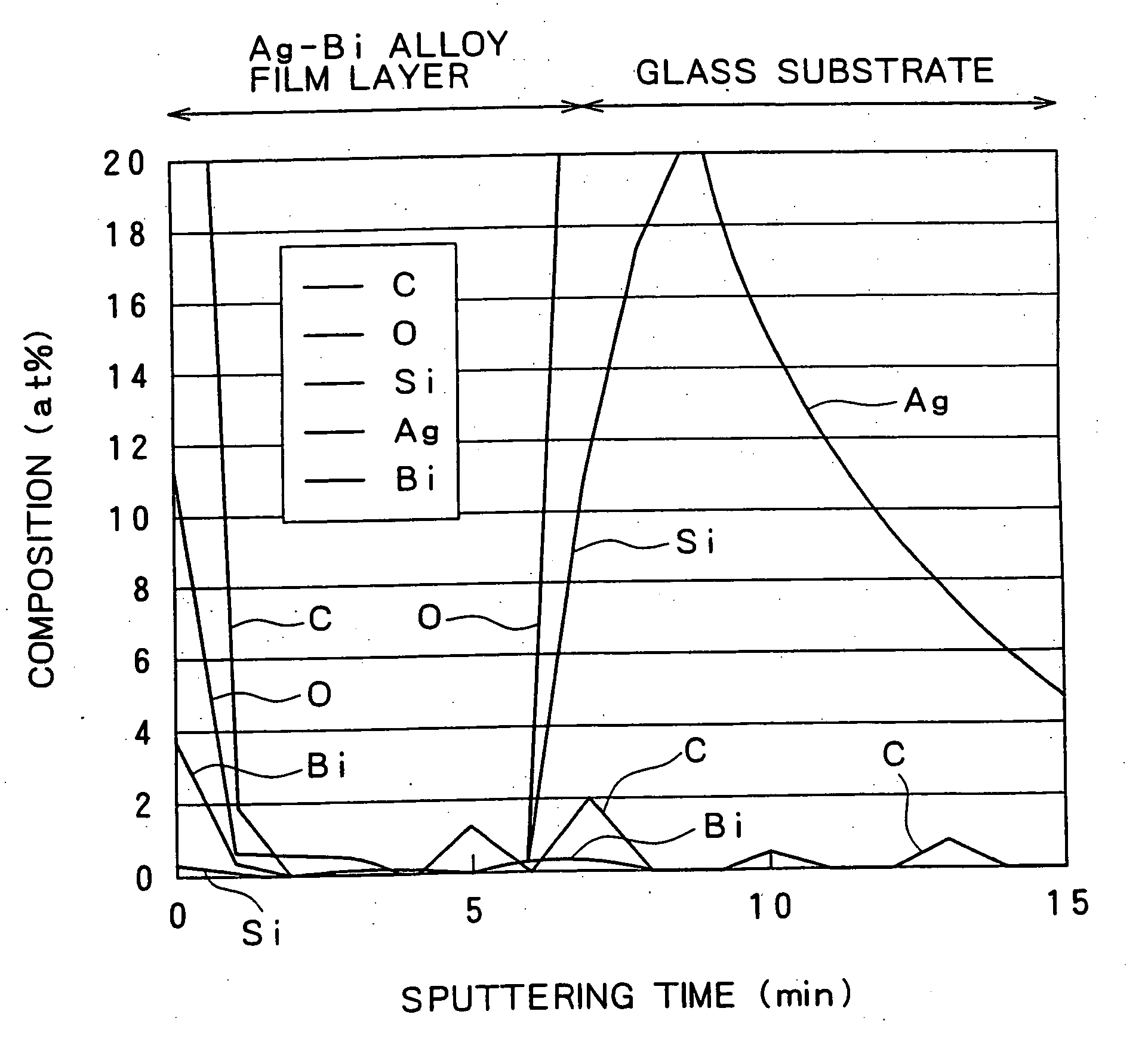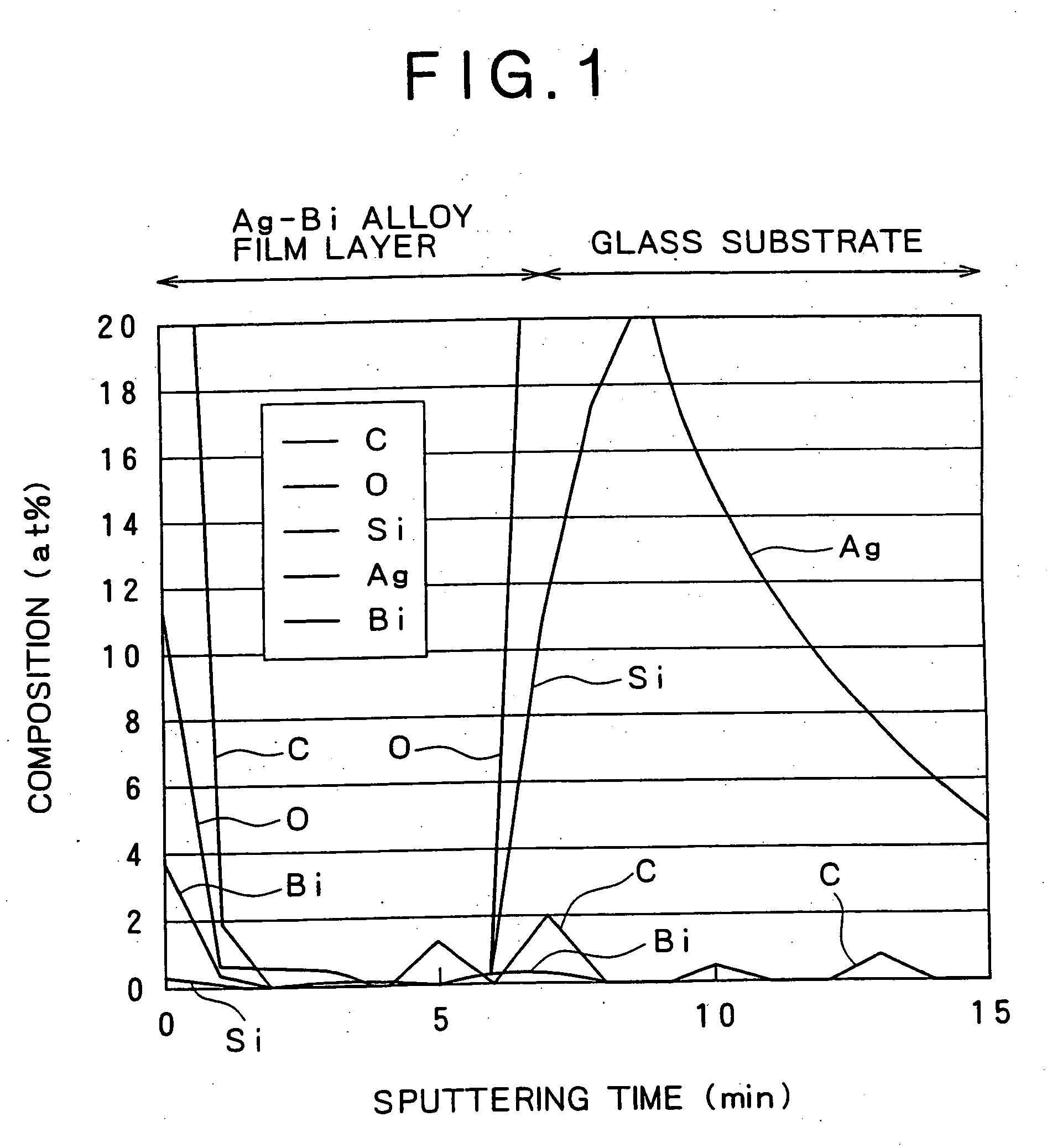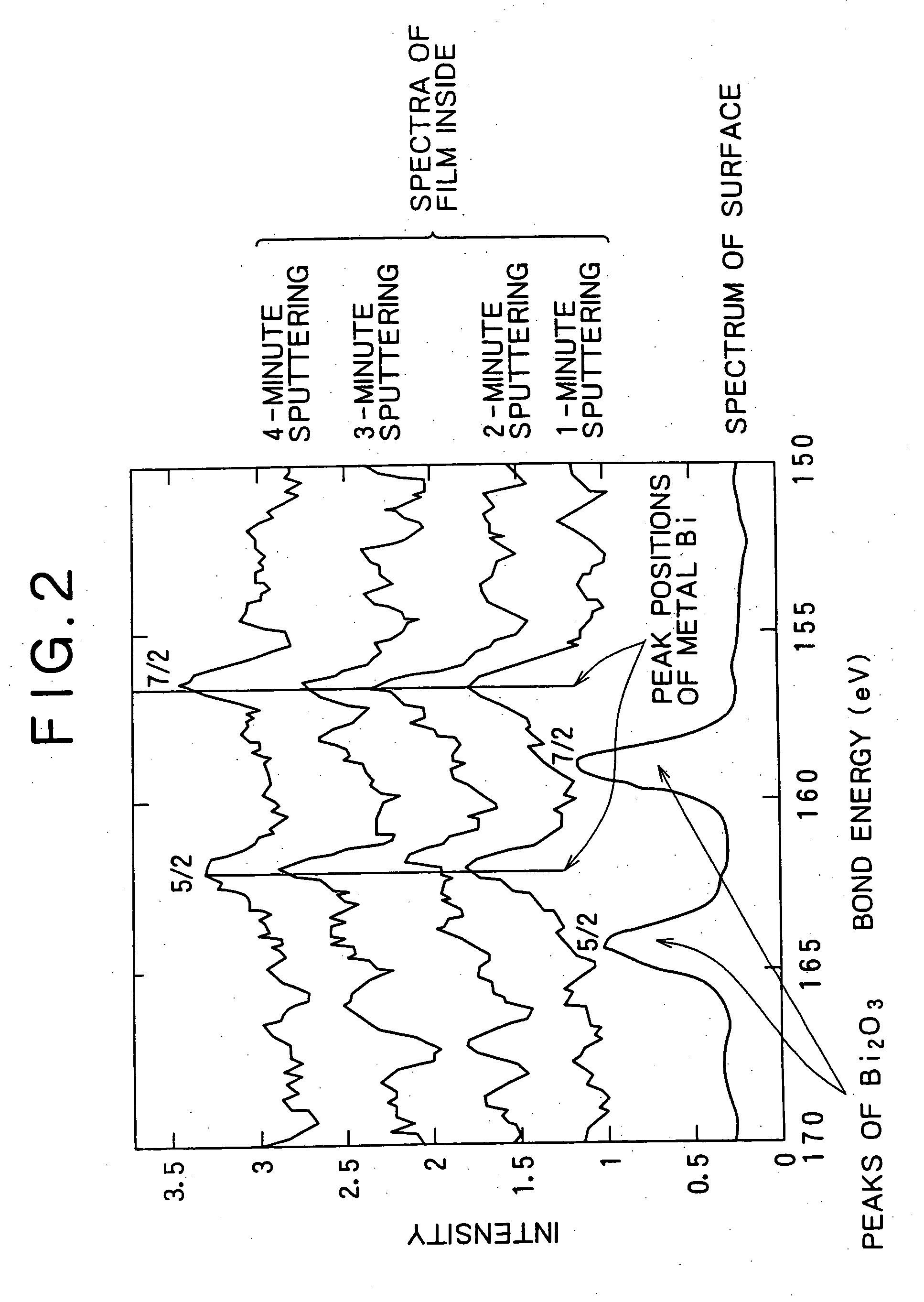Ag base alloy thin film and sputtering target for forming Ag base alloy thin film
a technology thin film, which is applied in the field of ag alloy films, can solve the problems of low abrasion resistance of ag film, no ag base alloy has been found which satisfies all these requirements, and the durability of ag film is not as high as that of ag base alloy, etc., to achieve high thermal conductivity/high reflectance/high durability, enhance recording and reproduction characteristics, and improve the reliability of optical information
- Summary
- Abstract
- Description
- Claims
- Application Information
AI Technical Summary
Benefits of technology
Problems solved by technology
Method used
Image
Examples
example 1
[0147] First, the measurement and evaluation method of each characteristic will be described below.
[0148] [Manufacturing of Ag Base Alloy Thin Film]
[0149] Using composite targets each formed by locating chips of various additive elements on a pure Ag sputtering target, each thin film of pure Ag (sample No. 1), Ag—Bi alloys (sample Nos. 2to5), Ag—Sb alloys (sample Nos. 6-9), Ag—Bi—Nd alloys (sample Nos. 10 to 14), Ag—Bi—Y alloys (sample Nos. 15-19), Ag—Sb—Nd alloys (sample Nos. 20 to 24), Ag—Sb—Y alloys (sample Nos. 25 to 29), Ag—Bi—Cu alloys (sample Nos. 30 to 34), Ag—Bi—Au alloys (sample Nos. 35 to 39), Ag—Sb—Cu alloys (sample Nos. 40 to 44), Ag—Sb—Au alloys (sample Nos. 45to49), Ag—Bi—Nd—Cu alloy (sample No. 50), Ag—Bi—Nd—Au alloy (sample No. 51), Ag—Bi—Y—Cu alloy (sample No. 52), Ag—Bi—Y—Au alloy (sample No. 53), Ag—Sb—Nd—Cu alloy (sample No. 54), Ag—Sb—Nd—Au alloy (sample No. 55), Ag—Sb—Y—Cu alloy (sample No. 56), Ag—Sb—Y—Au alloy (sample No. 57), Ag—Si alloy (sample No. 58), a...
example 1-1
Measurement of Thermal Conductivity
[0151] The thermal conductivity of each thin film with a thickness of 100 nm manufactured as described above was measured in the following manner. The sheet resistance Rs was measured with a four probe method by means of 3226-mΩ Hi TESTER manufactured by HIOKI Co, and the film thickness t was measured by means of alpha-step 250 manufactured by TENCOR INSTRUMENTS Co. Then, the electrical resistivity ρ(=sheet resistance Rs×film thickness t) was calculated, and then, the thermal conductivity κ(=2.51×absolute temperature T / electrical resistivity ρp) at an absolute temperature of 300 K (≈27° C.) was calculated by the law of Wiedemann-Franz. Incidentally, for the evaluation, the one showing 256 W / (m·K) or more, which corresponds to 80 percent or more of the thermal conductivity: 320 W / (m·K) of a pure Ag thin film has been judged as having high thermal conductivity. The results are shown in Tables 1 and 2.
[0152] As apparent from Tables 1 and 2, any of t...
example 1-2
Measurement of Reflectance
[0153] The reflectance with respect to a visible light (wavelength: 400 to 800 nm) of each thin film with a thickness of 100 nm manufactured in the foregoing manner was measured by means of Polar Kerr Scope NEO ARK MODEL BH-810 manufactured by Nihon Kagaku Engineering Co. Incidentally, for the evaluation of high reflectance, the one showing 80% or more (wavelength 405 nm) and 88% or more (wavelength 650 nm) relative to 90.8% (wavelength 405 nm) and 92.5% (wavelength 650 nm), respectively, which are the reflectances of the pure Ag thin film has been judged as having a high reflectance. Herein, the wavelength of 405 nm is the wavelength of a laser light to be used for a next-generation optical disk, and the wavelength of 650 nm is the wavelength of a laser light to be used for a DVD. The results are shown in Tables 3 and 4.
[0154] As apparent from Tables 3 and 4, any of the pure Ag thin film (sample No. 1), the thin films of the Ag—Si alloy (sample No. 58) a...
PUM
| Property | Measurement | Unit |
|---|---|---|
| thickness | aaaaa | aaaaa |
| thicknesses | aaaaa | aaaaa |
| thicknesses | aaaaa | aaaaa |
Abstract
Description
Claims
Application Information
 Login to View More
Login to View More - R&D
- Intellectual Property
- Life Sciences
- Materials
- Tech Scout
- Unparalleled Data Quality
- Higher Quality Content
- 60% Fewer Hallucinations
Browse by: Latest US Patents, China's latest patents, Technical Efficacy Thesaurus, Application Domain, Technology Topic, Popular Technical Reports.
© 2025 PatSnap. All rights reserved.Legal|Privacy policy|Modern Slavery Act Transparency Statement|Sitemap|About US| Contact US: help@patsnap.com



